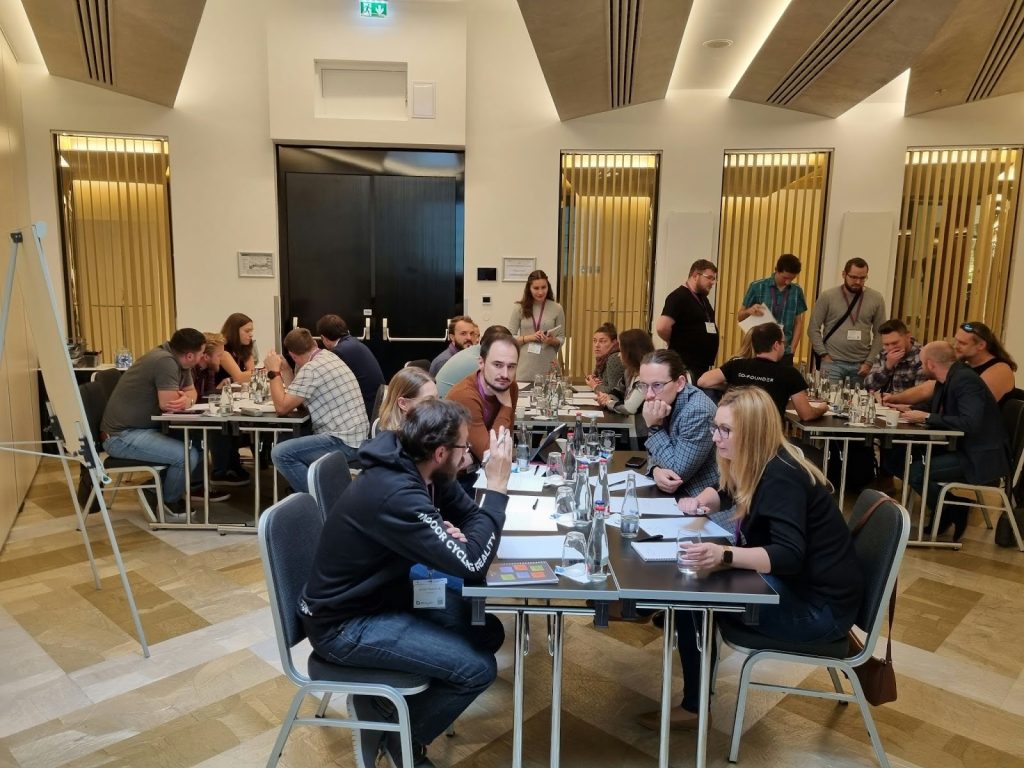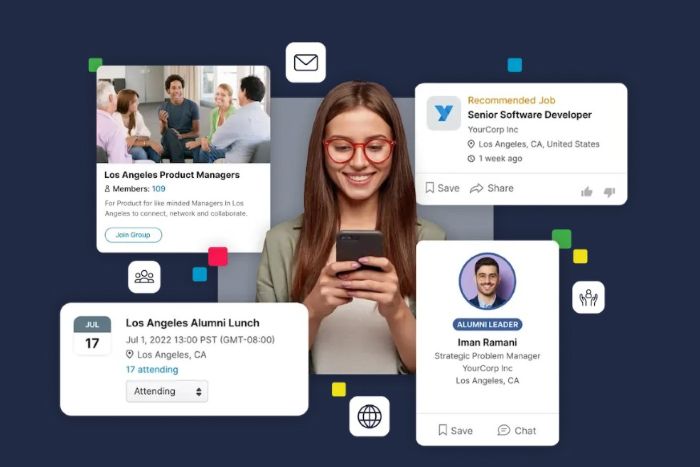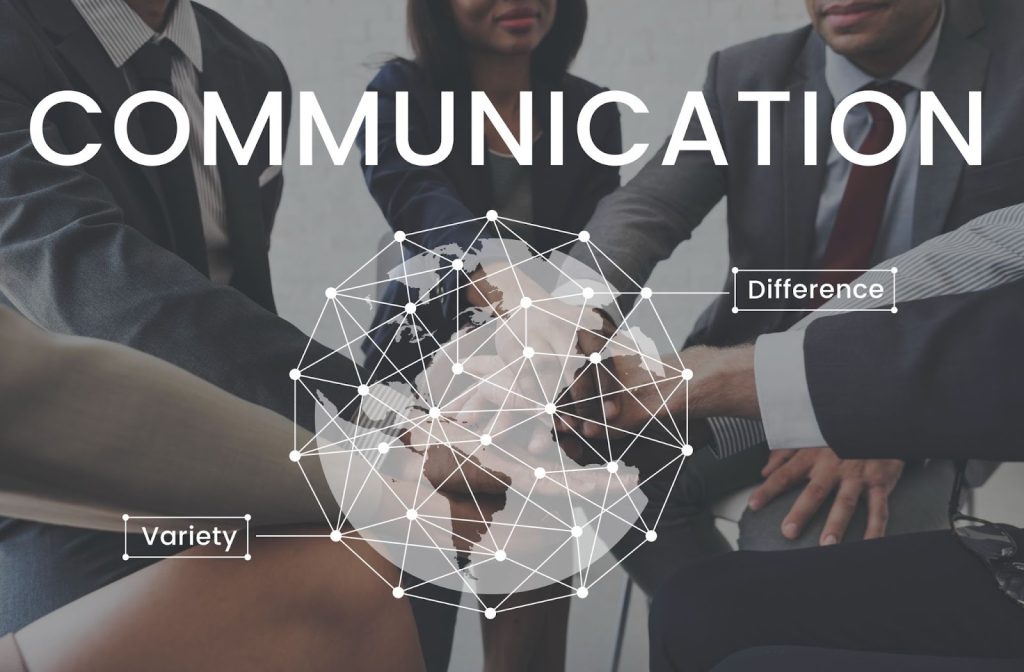When employees leave your organization, most companies treat it as the end of a relationship. Exit interviews happen, company equipment gets returned, access badges are collected, and everyone moves on. But this traditional approach to employee departures represents one of the most significant missed opportunities in modern business strategy. Your former employees carry with them intimate knowledge of your company culture, deep understanding of your products and services, relationships with current staff, and genuine affinity for your brand.
They move into new roles at other organizations, taking with them insights that could become partnerships, referrals, or even boomerang opportunities where they return as employees. Yet most companies let these valuable connections drift away after the goodbye email.
The world’s most sophisticated organizations have figured out something important. Alumni aren’t just former employees. They’re a strategic network that can drive recruitment, business development, brand advocacy, and competitive intelligence when nurtured properly. Companies like McKinsey, Deloitte, and Goldman Sachs have maintained alumni programs for decades, recognizing that their former consultants and analysts become clients, partners, and talent sources throughout their careers.
What’s changed recently is that this alumni strategy is no longer exclusive to elite professional services firms. Technology platforms have democratized corporate alumni engagement, making it practical and affordable for organizations of all sizes to maintain these valuable relationships systematically. The results speak for themselves through reduced recruitment costs, expanded business pipelines, and strengthened employer brands.
This article explores why corporate alumni networks have become essential business infrastructure and how organizations are leveraging modern platforms to transform former employees into lasting strategic assets.
Table of contents
The Business Case for Organized Alumni Engagement
The financial case for corporate alumni programs becomes clear when you examine the hidden costs of ignoring this population. Consider recruitment alone. The average cost to hire a new employee ranges from $4,000 to over $20,000 depending on the role and industry. A significant portion of that cost goes to sourcing, screening, and evaluating candidates who may or may not fit your culture.
Your alumni already understand your culture intimately. They know what it takes to succeed in your environment. When they refer candidates from their networks, those referrals come with implicit endorsement and cultural pre-screening. Studies consistently show that employee referrals have higher retention rates, faster time-to-productivity, and better cultural fit than candidates from other sources.
But alumni referrals represent just the beginning. Former employees who land in client organizations become warm introductions for business development. They understand your capabilities and can advocate internally at their new companies. In B2B contexts especially, having alumni embedded in customer organizations creates relationship capital that competitors can’t easily replicate.
The boomerang phenomenon has grown significantly over the past decade. Stigma around returning to former employers has largely disappeared, and many professionals now view career moves as ways to gain different experiences before potentially returning. Companies report that boomerang employees typically perform at higher levels than new hires, require less training, and demonstrate greater loyalty the second time around.
Brand advocacy from alumni extends your employer brand reach exponentially. When former employees speak positively about their experience at your company, it carries more authenticity than any corporate messaging. They provide honest testimonials about company culture, development opportunities, and leadership quality that prospective employees trust implicitly.
The challenge hasn’t been recognizing alumni value. It’s been having practical systems to maintain these relationships at scale without creating unsustainable manual work for HR teams or individual managers. This is where purpose-built technology makes the difference between theoretical value and realized results.

Building Systematic Alumni Engagement
Moving from recognizing alumni value to actually capturing it requires systematic approaches that scale beyond individual relationships. The most successful corporate alumni programs share several characteristics that separate them from informal networks that lose momentum over time.
First, they establish clear strategic objectives. What specific business outcomes should your alumni program drive? Some organizations prioritize recruitment referrals. Others focus on business development and partnership opportunities. Many pursue multiple objectives simultaneously. Defining these goals upfront ensures you measure the right metrics and design engagement activities that actually move the needle.
Second, they create ongoing value propositions for alumni. The relationship can’t be one-sided where companies only reach out when they need something. Effective alumni programs provide continuing benefits that give former employees reasons to stay engaged. This might include exclusive content, professional development resources, networking opportunities, career support, or inside access to company developments.
Third, they leverage technology platforms designed specifically for alumni management rather than trying to repurpose employee systems or rely on general social networks. The requirements for alumni engagement differ substantially from internal employee tools. You need to maintain detailed alumni profiles, segment populations for targeted communications, facilitate networking between alumni, promote opportunities, and measure engagement over time.
Purpose-built alumni platforms provide the infrastructure that makes systematic engagement practical. These systems centralize alumni data, automate communication workflows, enable self-service networking, and provide analytics showing which engagement activities drive desired outcomes. Without dedicated platforms, alumni programs typically devolve into sporadic emails and occasional events that generate minimal return on investment.

Technology That Powers Modern Alumni Programs
The evolution of alumni platform technology has fundamentally changed what’s possible in corporate alumni engagement. Early approaches relied on basic databases, email lists, and manual event coordination. Modern platforms provide comprehensive ecosystems that automate much of the operational overhead while creating engaging experiences for alumni.
Contemporary alumni platforms centralize all alumni data in secure, searchable directories that alumni can update themselves. This self-service model ensures information stays current without requiring HR teams to manually maintain thousands of records. Alumni can search for former colleagues, filter by current company or location, and reconnect through platform messaging.
Targeted communication capabilities allow segmented outreach based on any combination of factors including tenure, department, skills, location, and current company. When you’re recruiting for specific roles, you can communicate opportunities directly to alumni with relevant backgrounds. When expanding in particular markets, you can reach alumni now working in those regions. This precision prevents the mass-blast communications that cause people to tune out.
Job boards integrated into alumni platforms create channels for sharing opportunities specifically with alumni networks. Many companies find alumni referrals through dedicated platforms significantly outperform general job postings because you’re reaching candidates who already understand and value your culture.
Event management features handle everything from registration to attendance tracking for alumni gatherings. Whether hosting regional meetups, industry-specific events, or annual reunions, integrated event tools streamline logistics while capturing engagement data that shows which alumni remain active in the network.
Content libraries provide ongoing value by sharing company news, industry insights, professional development resources, and exclusive updates that aren’t available publicly. This consistent value creation gives alumni reasons to return to the platform regularly rather than only engaging when they receive occasional emails.
Analytics dashboards reveal which alumni remain engaged, what content resonates, which communication approaches drive responses, and ultimately how alumni activities contribute to recruitment, business development, and other strategic objectives. This data-driven approach allows continuous refinement of alumni strategies based on actual results rather than assumptions.
The EnterpriseAlumni trusted alumni platform exemplifies the sophistication available in modern alumni technology, providing comprehensive features that transform alumni management from administrative burden into strategic capability. Organizations implementing dedicated platforms consistently report higher alumni engagement rates, better recruitment outcomes, and measurable business value compared to informal approaches.
What distinguishes leading platforms is their focus specifically on corporate alumni needs rather than trying to adapt systems built for other purposes. The feature sets, user experiences, and integration capabilities reflect deep understanding of how companies actually want to engage alumni and what outcomes they’re trying to achieve.

Best Practices From Successful Alumni Programs
Organizations achieving meaningful results from alumni programs follow patterns worth understanding whether you’re launching a new program or revitalizing an existing one. These practices transcend industry and company size, representing fundamental principles of effective alumni engagement.
Start with executive sponsorship that signals organizational commitment. Alumni programs succeed when leadership clearly communicates that maintaining these relationships matters strategically. This sponsorship ensures adequate resourcing, cross-functional collaboration, and sustained attention beyond initial launch enthusiasm.
Define specific, measurable objectives tied to business outcomes. Vague goals like “staying connected” don’t provide direction or allow measurement. Concrete targets such as generating 20% of new hires through alumni referrals or sourcing 15 qualified sales leads per quarter give you clear success metrics and justify continued investment.
Segment your alumni population thoughtfully. Not all former employees represent equal opportunity or interest. Focusing energy on high-potential segments including recent departures, high performers, employees who left in good standing, and alumni in strategic industries or roles ensures efficient resource allocation.
Create compelling content strategies that provide genuine value. Share industry insights that help alumni in their current roles. Provide career development resources. Offer exclusive access to company updates before they’re public. Celebrate alumni achievements. Content that serves alumni interests drives engagement far more effectively than purely company-focused messaging.
Host regular events both virtually and in person when possible. Alumni appreciate opportunities to reconnect with former colleagues, expand their networks, and maintain relationships with the organization. Events don’t need to be elaborate. Simple happy hours, speaker series, or virtual coffee connections can drive significant engagement when executed consistently.
Make it easy for alumni to give back. Clear pathways for referring candidates, making customer introductions, speaking at company events, or mentoring current employees remove friction that prevents willing alumni from contributing. The easier you make participation, the more alumni will engage in mutually beneficial ways.
Measure relentlessly and refine continuously. Track participation rates, referral quality, business development outcomes, and boomerang hiring success. Use this data to identify what works and double down while eliminating activities that don’t drive results. The best alumni programs continuously evolve based on performance data.
Integrate alumni program data with other business systems. Connecting alumni platforms with applicant tracking systems, CRM platforms, and HR information systems creates seamless workflows that make it easy to act on alumni engagement. When recruiters can see that a strong candidate came through alumni referral, or when sales teams know which prospects have alumni connections, that context enables better decision-making.

Overcoming Common Alumni Program Challenges
Even well-designed alumni programs face predictable challenges that can derail effectiveness if not addressed proactively. Understanding these obstacles and how successful organizations overcome them helps you anticipate and solve problems before they undermine results.
The cold start problem affects new alumni programs. Without existing engaged alumni, how do you create initial momentum? Successful launches typically focus on recent departures first since they have freshest connections and highest likelihood of engagement. Early wins with this population create social proof that attracts broader participation.
Data quality issues plague programs that inherit incomplete or outdated information from HR systems. Former employees change companies, relocate, and update their professional profiles, but these changes don’t automatically flow back to alumni databases. Self-service profile management where alumni maintain their own information solves this but requires giving them compelling reasons to keep data current through valuable platform features.
Engagement decay over time represents perhaps the most common challenge. Initial launch enthusiasm fades if the program doesn’t provide consistent value. Combating decay requires sustained content creation, regular communication, ongoing events, and continuous demonstration of value through job opportunities, networking benefits, and exclusive access.
Privacy concerns and data security deserve careful attention. Alumni rightfully expect their information to be protected and only used appropriately. Clear privacy policies, robust security measures, and transparent communication about how data will be used build the trust necessary for alumni to engage openly.
Resource constraints limit what many HR teams can accomplish with alumni programs. This challenge makes technology platforms especially valuable since they automate much of the operational work that would otherwise require substantial manual effort. The Alumni platform software by EnterpriseAlumni handles communication automation, profile management, and engagement tracking that would be impractical to manage manually at scale.
Cross-functional alignment challenges emerge when alumni programs sit exclusively in HR while the benefits accrue to recruiting, sales, and other departments. Solving this requires governance models that involve stakeholders across the organization and demonstrate value to multiple functions through shared metrics and reporting.
Global complexity adds layers of difficulty for multinational organizations. Different regions have varying data privacy regulations, cultural norms around alumni engagement, and practical considerations for events and communications. Successful global programs balance centralized strategy and technology with localized execution that respects regional differences.
The Future of Alumni Networks
Corporate alumni programs will only grow in strategic importance as workplace dynamics continue evolving. Several trends suggest the next decade will see alumni networks become standard business infrastructure rather than progressive HR experiments.
The shift toward project-based work and portfolio careers means professionals will have more employers throughout their working lives. Companies that maintain positive alumni relationships benefit disproportionately in this environment since they remain options for multiple engagements rather than single tenures. The concept of lifetime employment evolves into lifetime relationships.
Remote work expansion has created truly distributed workforces where location matters less. Alumni networks benefit from this trend since geographic barriers to maintaining connections have largely dissolved. An alumni event can now be a Zoom call reaching hundreds of former employees globally rather than a single-city gathering.
Generational shifts in expectations about employer relationships favor alumni-friendly approaches. Younger professionals expect to move between organizations more frequently and view career development through varied experiences positively rather than as job hopping. Companies that embrace this reality through strong alumni programs are seen as confident and supportive rather than clingy or possessive.
Technology capabilities will continue advancing, making alumni engagement more personalized, automated, and integrated with other business systems. AI will help identify the most promising alumni for specific opportunities, predict which former employees might return as boomerang hires, and personalize communications based on individual interests and career paths.
The measurement of alumni program ROI will become more sophisticated as organizations track long-term value beyond immediate recruitment or sales outcomes. Understanding lifetime value of alumni relationships, including how alumni networks compound over years, will justify deeper investments in systematic engagement.

Taking Action on Alumni Strategy
If you’re convinced of alumni networks’ strategic value but haven’t systematically engaged this population, now represents an opportune moment to begin. The technology barriers that once made alumni programs impractical for most organizations have disappeared. The business case has become clear through data from companies already achieving results. What remains is commitment to treating alumni relationships as the strategic assets they are.
Start by auditing your current state. How many former employees do you have contact information for? What percentage left in good standing? Do you have any existing touchpoints with alumni even informally? Understanding your starting point helps set realistic initial objectives.
Define what success looks like for your organization specifically. Don’t just copy what other companies do. Think about your unique challenges in recruitment, business development, or employer branding that alumni might help address. Set concrete, measurable goals that justify the investment you’ll make.
Choose technology that matches your ambitions and resources. If you’re just exploring alumni engagement, simple platforms with core features might suffice. If you’re serious about building lasting competitive advantage through alumni relationships, invest in comprehensive solutions with proven track records.
Build a cross-functional team representing HR, recruiting, marketing, and business development. Alumni programs fail when they’re siloed in single departments without broader organizational buy-in. Create governance that includes stakeholders who benefit from alumni engagement.
Plan for sustained effort rather than expecting immediate results. Alumni programs build value over time as networks grow, engagement patterns mature, and results compound. Companies that commit to multi-year strategies achieve dramatically better outcomes than those seeking quick wins.
The competitive landscape increasingly favors organizations that build lasting relationship capital with all stakeholders including former employees. Your alumni network represents unrealized potential waiting to be activated. The question isn’t whether alumni relationships have value but whether you’ll capture that value through systematic engagement or leave it for competitors to claim.











